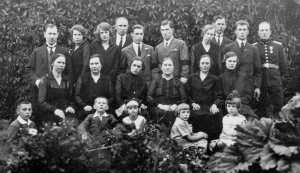Time for Week 31 of the 52 Ancestors in 52 Weeks Challenge! As noted in my first post of this challenge, I am starting with my most ancient known ancestors.
This week’s ancestor is Ansis EglÄ«tis, born c. 1818, died after 1858. He is my great-great-great-grandfather by way of my maternal grandfather’s maternal grandfather, Ansis EglÄ«tis.
Yes, as you can tell, we have another case of repeating names – my many generations of PÄ“teris Celmiņš’ are not the only repeating name I have. In this case, however, there are only two – a father and son. Today, we are talking about the father, who was the son of Andrejs EglÄ«tis and his wife LÄ«ze. He was born and lived all of his life, to my knowledge at least, on LangaÄi farm on Limbaži estate in northern Latvia.
I now know I made a bit of an error in the entry on Ansis’ father Andrejs – looking at the 1816 revision list (without surnames, but ages match up to 1826), it turns out there were three children born before Ansis – TrÄ«ne (born c. 1798), BrediÄ·is (born c. 1803 and died 1813) and Marija (born c. 1806). Since Ansis was the oldest surviving son in 1826, that is probably why he is listed as the first son, even though he was technically second. So it seems that Andrejs and LÄ«ze married at a “normal” age after all, and simply had a number of kids raised and out of the house before the younger group were born. Though I do still suspect that LÄ«ze may have been a second wife – her age compared to TrÄ«ne would have made her about 17 when she was born – not impossible, but it was unusual for Latvians to marry that young, and given the five year gap between TrÄ«ne and Bredikis, this could also be a sign.
At any rate, back to Ansis. Given the ages, Ansis married Anna sometime between 1840 and 1848. However, the marriage does not appear in any Limbaži records from that time, so that probably means that Anna was from another parish, and the marriage took place there. I have not yet had the opportunity to search the other nearby parishes for their marriage. But I do know that wherever she was from, the family was living on LangaÄi farm in 1850 at the time of the revision list, where Ansis and Anna are listed with two sons, Andrejs and Ansis Junior. The 1858 revision list adds another brother, MÄrtiņš. I’m not certain if Ansis Senior had any more children afterwards, but if he did, it is important to be careful looking through the records for them, since there are numerous other Ansis EglÄ«tis’ from other related families running around as well. Though Ansis Senior and Junior were the only ones living in LangaÄi in 1858, so that will help with accuracy.
The 1858 revision list is the last news that I have of Ansis Senior. I have not yet had the opportunity to look for a death record. But again, like above – any death record needs to be vetted carefully, since there are numerous other potential matches.
I have more information on his son Ansis and granddaughter MÄ“rija – but for them, we’ll have to wait for different weeks!

